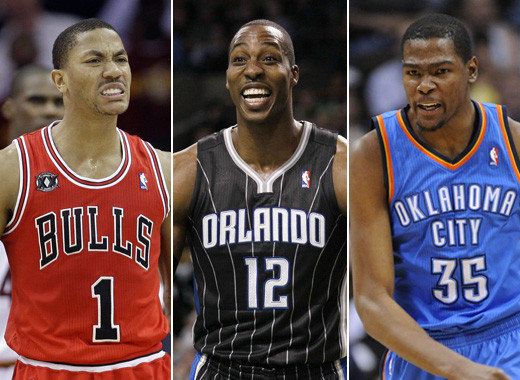
The NBA Playoffs are on the horizon -- meaning it’s time to break down the annual NBA awards and distribute the hardware. To start it all off, we’re looking at the award that separates the best from everybody else. Jordan won five. LeBron has already won two. But now that he’s paired up with D-Wade in Miami, the award is most likely staying away from South Beach.
So, where will the Maurice Podoloff Trophy end up come May? Kevin Durant has continued his meteoric rise into the NBA’s elite as a prolific scorer, while Dwight Howard has armed himself with an improved offensive skillset to match his perennial Defensive Player of the Year caliber play at the other end of the floor. But it’s Derrick Rose, the young floor general for Chicago, who stands alone at the top. Rose has been sensational all season long with his highlight reel scoring, dynamic passing and all around leadership, propelling the Bulls to the best record in the Eastern Conference.
MVP:
1). Derrick Rose (Chicago) – In just his third season, the Chicago native has been nothing short of magnificent, elevating the Bulls from a once middling Eastern Conference team to a legitimate NBA title threat. While there was never a question he’d continue to have successful exercising his attacking style and ability to finish, Rose has quelled critics who questioned his suspect jumper coming out of Memphis.
He has certainly improved other elements of his game, especially his passing and overall decision making, but Rose has used the threat of a finely tuned jump shot to create havoc at the offensive end. His field goal percentage is slightly down from last year, but his three-point and free throw percentages are way up (from 26.7 to 33.2 and 76.6 to 88.5, respectively). But, the great thing about Rose is that -- given his explosiveness and sheer playmaking ability -- he never needed to become Ray Allen. He simply needed to shed the “Rondo effect” and force defenders to honor his range so he could do what he does best: attack the basket.
Fine turning his shot has helped him distribute the ball as well. The 22 year old is averaging a career best 7.9 assists. In addition to the ability to beat his man off the bounce and create in the lane, another notable improvement in Rose’s game is his aptitude in running the screen-and-roll. While Carlos Boozer and Joakim Noah both excel out of these situations, it has been Rose’s willingness and patience to find them that’s made it so successful. And when Boozer and Noah went down with injuries, it was Rose who kept the Bulls in the hunt with his scoring outbursts and heavy minutes.
Some point guards can run the pick-and-roll well, but can’t do much else. Rose can also break the defense with the high ball screen or from either wing. And if the defense gets overzealous by hedging too high, he’ll just split them in half and finish in the paint with his patented teardrop runner.
His team has reaped the benefits of Rose’s improved play. Thanks to his 25 points per game, superior passing and commitment to the defensive end, the Bulls are 57-20, first in the East, and a legitimate contender for the first time since a certain “Airness” ruled the United Center.
2). Dwight Howard (Orlando) – If Derrick Rose’s biggest question mark was his jump shot, then Dwight Howard’s was his post game. For most of his first six years in the league, Howard was a brute-force center: a rebounding machine that scored largely off of put backs and dirty work. Sure, Howard flashed the occasional sign of interior dominance on the block, but he never displayed the consistency of an elite offensive center.
We have seen an evolution of ‘Superman’ this season. In part thanks to offseason work with Hakeem Olajuwon, Howard has developed a consistent low post game replete with an impressive flurry of moves. His drop-step move is flat-out unstoppable, while his left hand, once a considerable weakness, has now become a weapon.
Most big men, especially in their youth, only go to their strong hand. Blake Griffin is terrific, but he loves to go left shoulder, and if he does go the other way, often times he’ll use the up-and-under to avoid using the left. Howard is so big and strong that all he really
needed was to get more extension with it to become effective. His near 60 percent shooting is good enough for second best in the NBA, and his offensive development is a vital reason why.
Using his athleticism and strength, Howard has continued to be force on the glass and the defensive end, perhaps the two most crucial elements for any center. Howard is averaging 14.2 rebounds and 2.35 per game, both second best in the league. His ability to completely shut down the paint and dissuade drivers is why Orlando, void of any true lock-down perimeter defenders, remains fifth in points allowed and is still a threat to take the East.
3). Kevin Durant (Oklahoma City) – Last season’s scoring champ, Durant gets buckets with an ease unlike any other player in the game today. The once waifish Durant has transformed into a lean yet strong forward that can literally beat you from any part of the floor.
The beauty of Durant is he gives 40 points without even the slightest hint of selfishness. Not only is he efficient, but KD plays within the offense. He is unstoppable in isolation opportunities, but also intelligent enough to recognize the attention he draws and, thus, is adept at finding open teammates. Russell Westbrook is a terrific young point guard, but a lot of the credit for his rise can be traced back to Durant. A dynamic scorer, Durant is also willing to defer when necessary and as a result, makes others better.
While he hasn’t taken the immense steps of last season, Durant clearly addressed his two most glaring weaknesses over the offseason: defense and post scoring. Not blessed with good lateral quickness, Durant has improved at using his length to bother scorers on the perimeter. Most importantly, he competes on the defensive end and isn’t afraid to mix it up with a hard foul just to let you know he’s still there.
Let’s not forget, though, that above all else, Durant is a killer -- a truly elite scorer. And for an elite perimeter scorer, learning how to operate with your back to the basket is one of the hardest things to do because you’re entire basketball career has been predicated off of scoring from the wing.
But, the post game is a priceless asset, particularly as players age and lose the blow-by ability. Kobe is a prime example of a dominant scorer who has extended his career by learning the intricacies of the post-up. Mastering the footwork and deception is challenging for many players used to starting their move on the perimeter.
Durant, at the ripe old age of 22, has for the first time shown a real consistency in his post-up scoring. His numbers are as consistent as ever, averaging close to 29 points and 7 rebounds while shooting over 88 percent from the stripe. The fact that he can now post up from 5' or 15’ is a great advantage and one that will serve him very well moving forward. With the tools now in place, he is utilizing his freakishly long 6-9 frame extremely well to shoot over the top of defenders. If he parlays this into capturing the MVP, he will become the youngest to do so in NBA history.
